Nephi’s Ship
In about 592 BC near Khor Kharfout, Oman in the Old World, a Prophet named Nephi was commanded to build a ship to take his family to a New Promised Land, which was the New World in North America. The Lord said, “Thou shalt construct a ship, after the manner which I shall show thee, that I may carry thy people across these waters.” Book of Mormon 1 Nephi 17:8
 Nephi said, “Now I, Nephi, did not work the timbers after the manner which was learned by men, neither did I build the ship after the manner of men; but I did build it after the manner which the Lord had shown unto me; wherefore, it was not after the manner of men.” 1 Nephi 18:2 About 590 BC
Nephi said, “Now I, Nephi, did not work the timbers after the manner which was learned by men, neither did I build the ship after the manner of men; but I did build it after the manner which the Lord had shown unto me; wherefore, it was not after the manner of men.” 1 Nephi 18:2 About 590 BC
How would this sailing vessel be built? How would it be different than other ships built around 600 BC, since the Lord said it should be “after the manner which the Lord had shown unto me?”
As I research I found the earliest known ships were built anciently as early as 5500 BC, as you will read below here: “Visual depictions of sailing boats have been dated as far back as 5500 BCE, discovered on painted discs from ancient Mesopotamia found in modern day Kuwait.” Jamey Bergman ybw.com
Bering Strait?
Now I believe Adam was placed on the earth in about 4,000 BC and the Jaredites left the Old World to America in about 2200 BC, so the 5500 BC may be dated incorrectly, but we know ships were built near the beginning of this earths existence after Adam.
I don’t believe the old myth about the peopling of the New World over the Bering Strait. I believe the Lord gave all mankind the knowledge to build ships similar to those of today. Sure each ship progressed from century to century, with the inspiration of the Lord to man, but the Lord created us all and gave us knowledge and abilities that are powerful at different points of time, as we needed, or as we most importantly asked, and researched on our own.
Sailboat Inventions 100 BC to 1500 AD:
Could these items below have been shown by the Lord to Nephi, near 590 BC to build after the manner of the Lord? The following are ship improvements after 600 BC.
1- The Lateen (triangular) sail: 100 BC
2- Steering Oars and Rudders 100 AD
3- The Keel: 700 – 900 AD
4- Carrack Sail: 1500 AD
Now, if the above improvements that were man-made inventions for ships and sailing in these time periods, what makes us think that the Lord could not have inspired Nephi to add some of these things to ships in 600 BC, or that Nephi asked the Lord how to do things and received inspiration to help his family arrive in North America near Florida? Before discussing the above 4 items I want to explain a few other things about boats sailing from the Old to the New Worlds.

“A sewn boat is a type of wooden boat which is clinker built with its planks sewn, stitched, tied, or bound together with tendons or flexible wood, such as roots and willow branches. Sewn boat construction techniques were used in many parts of the world prior to the development of metal fasteners, and continued to be used long after that time for small boats to reduce construction costs where metal fasteners were too expensive.” Wikipedia
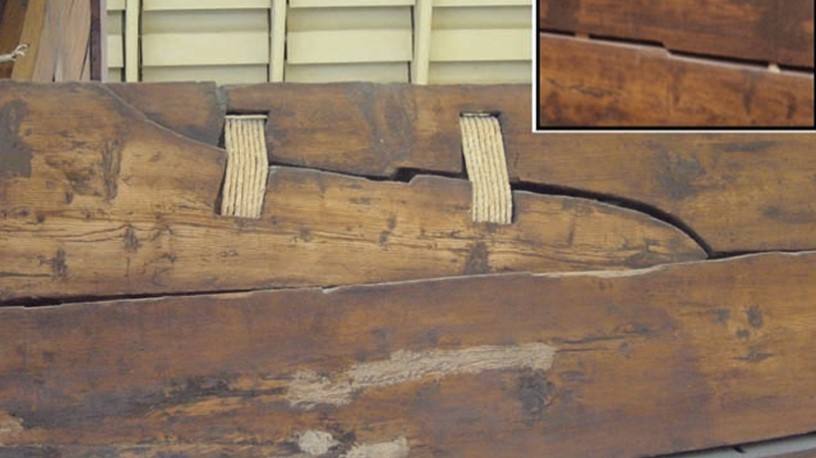
“Most of the joinery among the timbers was accomplished through means that allowed the hull to be deconstructed without destruction, “a deliberate goal of pharaonic shipbuilders… Joggled scarf joint of Khufu I (author’s photo right); Inset: joggled strakes of Khufu I. (courtesy Paul Lipke Collection).” Ship Timber and the Reuse of Wood in Ancient Egypt Pearce Paul Creasman University of Arizona
Jerusalem Destroyed
“The siege of Jerusalem (circa 589–587 BC) was the final event of the Judahite revolts against Babylon, in which Nebuchadnezzar II, king of the Neo-Babylonian Empire, besieged Jerusalem, the capital city of the Kingdom of Judah.” Wikipedia
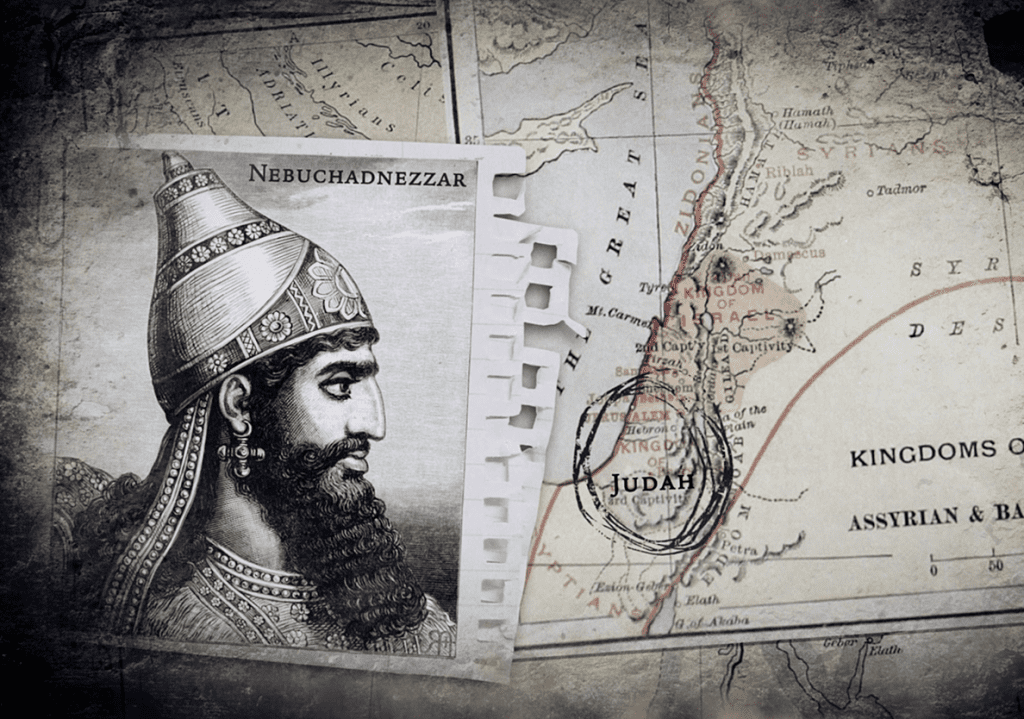 Remember about this same time somewhere near Jerusalem after the Temple was destroyed, a the last Prophet of Judah, named Zedikiah lived.”
Remember about this same time somewhere near Jerusalem after the Temple was destroyed, a the last Prophet of Judah, named Zedikiah lived.”
The Plates of Brass is a history of the Hebrew people which was brought by the people of Lehi and Nephi from Jerusalem in 600 BC to North America. These contained “the five books of Moses, as we read:
“And he beheld that they did contain the five of Moses, which gave an account of the creation of the world, and also of Adam and Eve, who were our first parents; And also a of the Jews from the beginning, even down to the commencement of the reign of Zedekiah, king of Judah; (1 Nephi 5:11–13).
Phoenicia Ship 600 BC
John Lefgren of Heartland Research said, “We believe the Phoenicia Ship Replica connects the Bible’s stories to the New World.
We read in Jeremiah 52:12 – 13. Now in the fifth month, in the tenth day of the month, which was the nineteenth year of Nebuchadrezzar king of Babylon, came Nebuzaradan, captain of the guard, which served the king of Babylon, into Jerusalem, And burned the house of the Lord, and the king’s house; and all the houses of Jerusalem, and all the houses of the great men, burned he with fire:
The destruction of Jerusalem and the burning of the First Temple had a profound impact on the history of the Jews. This is a point in time from which we connect the ship replica on the west bank of the Mississippi River to the Bible.
About 300 years after the destruction of Jerusalem, we read in Omni 15 Behold, it came to pass that Mosiah discovered that the people of Zarahemla came out from Jerusalem at the time that Zedekiah, king of Judah, was carried away captive into Babylon.
The ship shows that Mulek, the Prince of Judah, could sail across the Atlantic after the burning of the Temple. This is why we are so determined to find sufficient funds to finish the restoration of what was less than two years ago in the mud of Florida. We are sure that as we continue to move forward, we will gain the support of many more people.
Mulek, a son of King Zedekiah, may have come to Djerba with his mother, the Jewish Queen. Jews from Tunisia are sure to be able to tell this story better than anyone else. He wants to hear what the Rabbi has to say. Doug believes that the power of the Carthaginian Empire protected a remnant of the Jewish royal family. I think that this meeting will have great meaning as we connect the ancient people of Tunisia to the ancient people of America.” John Lefgren PhD
Below, embark on an Epic Journey Through Time! Join us in reliving the 6th Century BC Phoenician Ship Expedition, sailing from Syria to America and back. Witness the incredible seafaring prowess of the Phoenicia, a 2600-year-old replica ship inspired by the Jules Verne 7 Shipwreck. Support the reconstruction of this historic vessel in Montrose, Iowa, and be a part of something truly special. Phoenicia.Rocks
Two Hebrew Voyages to North America
We read in the Book of Mormon there were two groups that left the Old World Jerusalem area, about the same time frame that Jerusalem was destroyed. The Mulekites and the Lehites. See their potential routes below.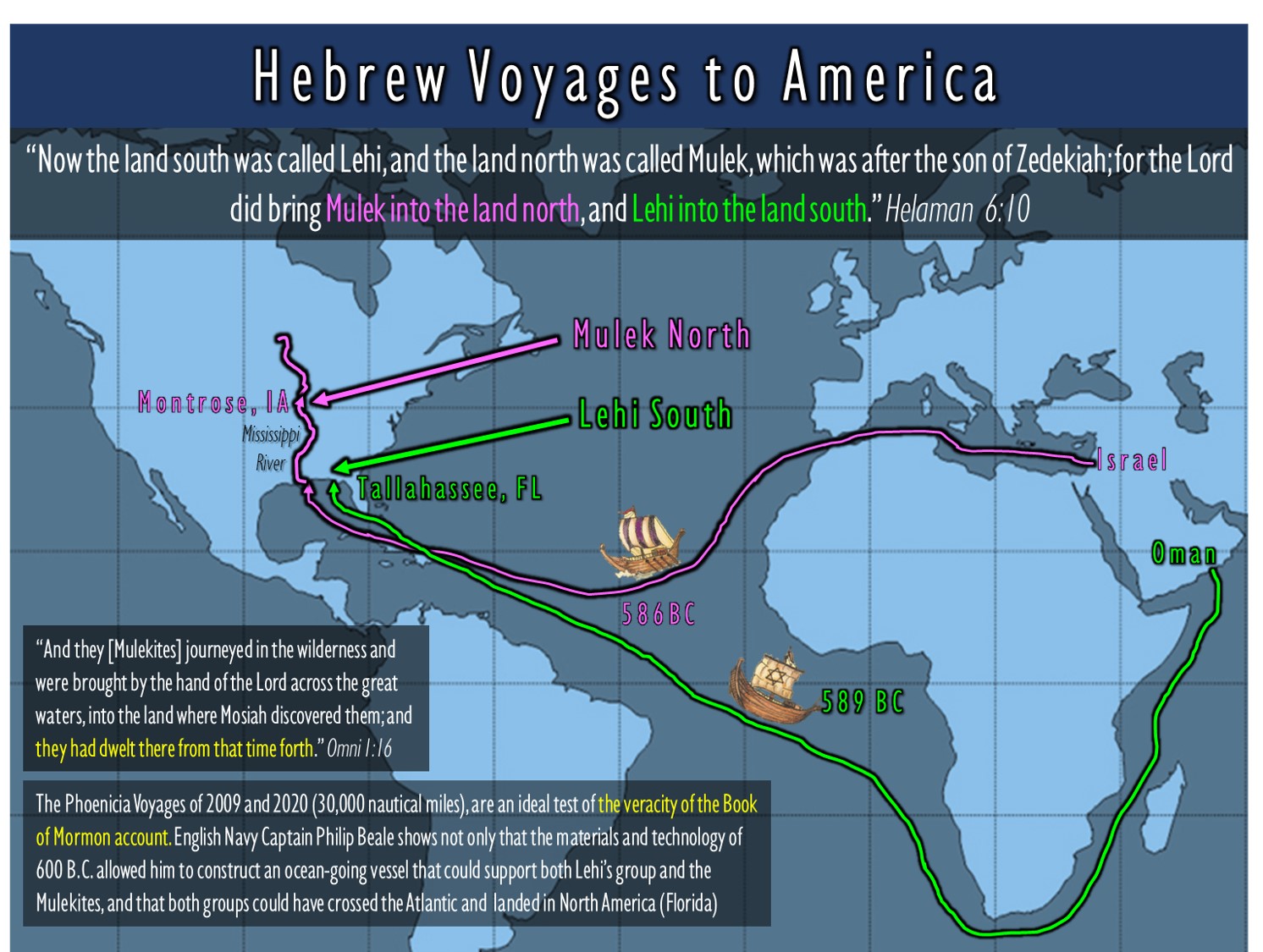
“Now the land south was called , and the land north was called , which was after the of Zedekiah; for the Lord did bring Mulek into the land north, and Lehi into the land south. Helaman 6:10
I believe that Lehi landed near Tallahassee, FL, and Mulek sailed up the Mississippi River and stopped at the Des Moines river rapids where as the scripture says, “And they journeyed in the wilderness, and were brought by the hand of the Lord across the great waters, into the land where Mosiah discovered them; and they had dwelt there from that time forth.” Omni 1:16
This means Mulek’s voyage was most likely a continuous voyage to the place they had been discovered by Mosiah. If Mulek had have gone up the St Lawrence seaway, if you look at a direct route to Montrose, Iowa where the Mulekites lived, would not be continuous. Sailing over the Great Lakes and the Niagara Falls would have been difficult, and they they would have had to stop near Detroit, and then find the Illinois river, then connect to the Mississippi river and then south to Montrose, Iowa. I feel up the Mississippi river from the south to the north makes more sense to me, but other people I love such as Wayne May believe the St Lawrence route. Either way is fine with me.
The First Sailing Boats: 5500 BC
“Visual depictions of sailing boats have been dated as far back as 5500 BCE, discovered on painted discs from ancient Mesopotamia found in modern day Kuwait.” Source
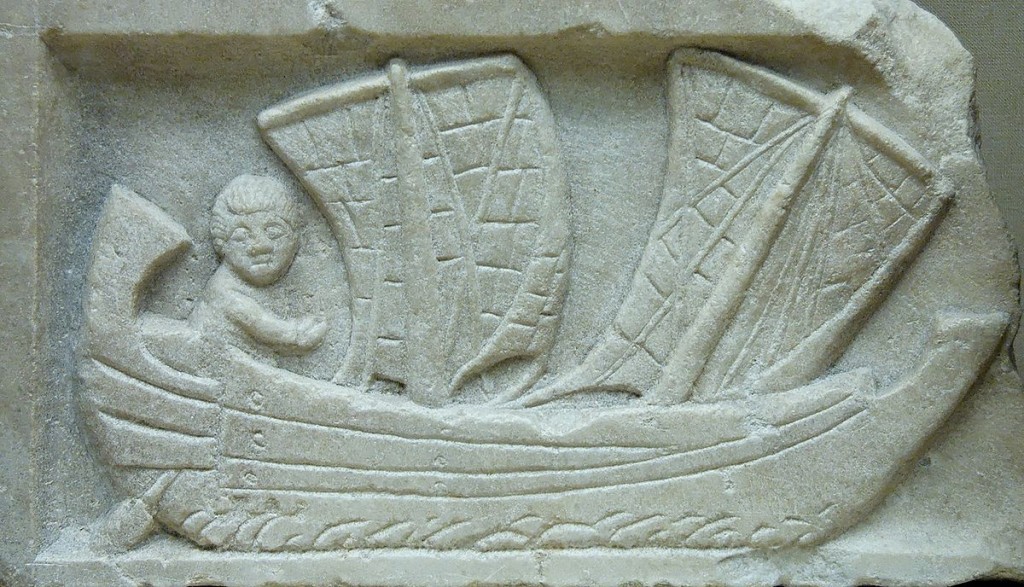 This quote above validates my personal belief that the Jaredites “did build [Their First Set of] barges, in which they did cross many waters, being directed continually by the hand of the Lord.” Ether 2:6. They crossed “many waters” (Not Great Sea, Ocean) but beginning near (Kuwait), or many waters like the Persian Gulf. After sailing through this Gulf, they continued eastward (possibly with sailing barges?), through the Gulf of Oman, Arabian Sea, Laccadive Sea, Bay of Bengal, Gulf of Thailand, South China Sea and the Philippine Sea. See my full blog here: They ended up in China or Japan to build their “2nd Set” of barges Ether 2: 16-17, before their 344 days on the Pacific, landing near Seattle, WA.
This quote above validates my personal belief that the Jaredites “did build [Their First Set of] barges, in which they did cross many waters, being directed continually by the hand of the Lord.” Ether 2:6. They crossed “many waters” (Not Great Sea, Ocean) but beginning near (Kuwait), or many waters like the Persian Gulf. After sailing through this Gulf, they continued eastward (possibly with sailing barges?), through the Gulf of Oman, Arabian Sea, Laccadive Sea, Bay of Bengal, Gulf of Thailand, South China Sea and the Philippine Sea. See my full blog here: They ended up in China or Japan to build their “2nd Set” of barges Ether 2: 16-17, before their 344 days on the Pacific, landing near Seattle, WA.
First Sail Boats More
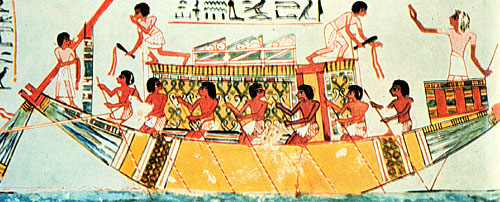 “Sailing was invented more than 7000 years ago. The first presented model of a ship under sail appears on a painted disc found in ancient Mesopotamia between 5500 and 5000 BCE. In modern-day Iraq-Kuwait. Another record appears on an Egyptian vase about 3500 BC. These sailing ships sailed on the Nile, Tigris, and Euphrates River.” Source
“Sailing was invented more than 7000 years ago. The first presented model of a ship under sail appears on a painted disc found in ancient Mesopotamia between 5500 and 5000 BCE. In modern-day Iraq-Kuwait. Another record appears on an Egyptian vase about 3500 BC. These sailing ships sailed on the Nile, Tigris, and Euphrates River.” Source
“4000 BC First Sailing Vessels: The ancient Egyptians develop the first sailing vessels. These vessels are probably only used for sailing in the eastern Mediterranean and near the mouth of the Nile river.” Source
Celestial Navigation by the Stars:
 “The prospect of navigating through a featureless landscape – like the sea at night – is still a daunting one for the uninitiated, and the fact that ancient cultures were able to achieve it is a testament to human ingenuity…
“The prospect of navigating through a featureless landscape – like the sea at night – is still a daunting one for the uninitiated, and the fact that ancient cultures were able to achieve it is a testament to human ingenuity…
The Lateen (triangular) Sail: 100 BC
One of the biggest jumps in the history of sailing technology was the invention of the lateen or latin-rig sail. The lateen is a triangular sail mounted at an angle and running in a fore-and-aft direction. With a maneuver called ‘tacking,’ the sail allows boats to make way to windward in a zig-zagging fashion. Though its exact origin is unknown, the lateen sail is the earliest-known fore-and-aft rigged sail and was in use in Greece in the first century BC. It is believed to have been introduced to the Mediterranean region by Arabic or Persian sailors. Polynesians also invented a mastless lateen-rigged sail that is very different in construction from that used in the Mediterranean…
Steering Oars and Rudders 100 AD

The invention of the stern-mounted rudder is credited to the Chinese, who came up with the idea of affixing a maneuverable steering apparatus to the back of a ship’s hull during or before the first century AD during the Han Dynasty. It took Western civilizations another thousand years to affix a stern-mounted rudder to ships…
The Keel: 700 – 900 AD
A structural beam that runs from a ship’s bow to its stern and sits lower than the rest of the hull, the keel was first invented by those intrepid Norse sailing men known as Vikings. Because their sailing ships were square-rigged, they were prone to making a lot of leeway when tacking close to the wind. The addition of a keel prevented this lateral movement, increased speed and made Viking ships more stable…
Carrack Sail: 1500 AD
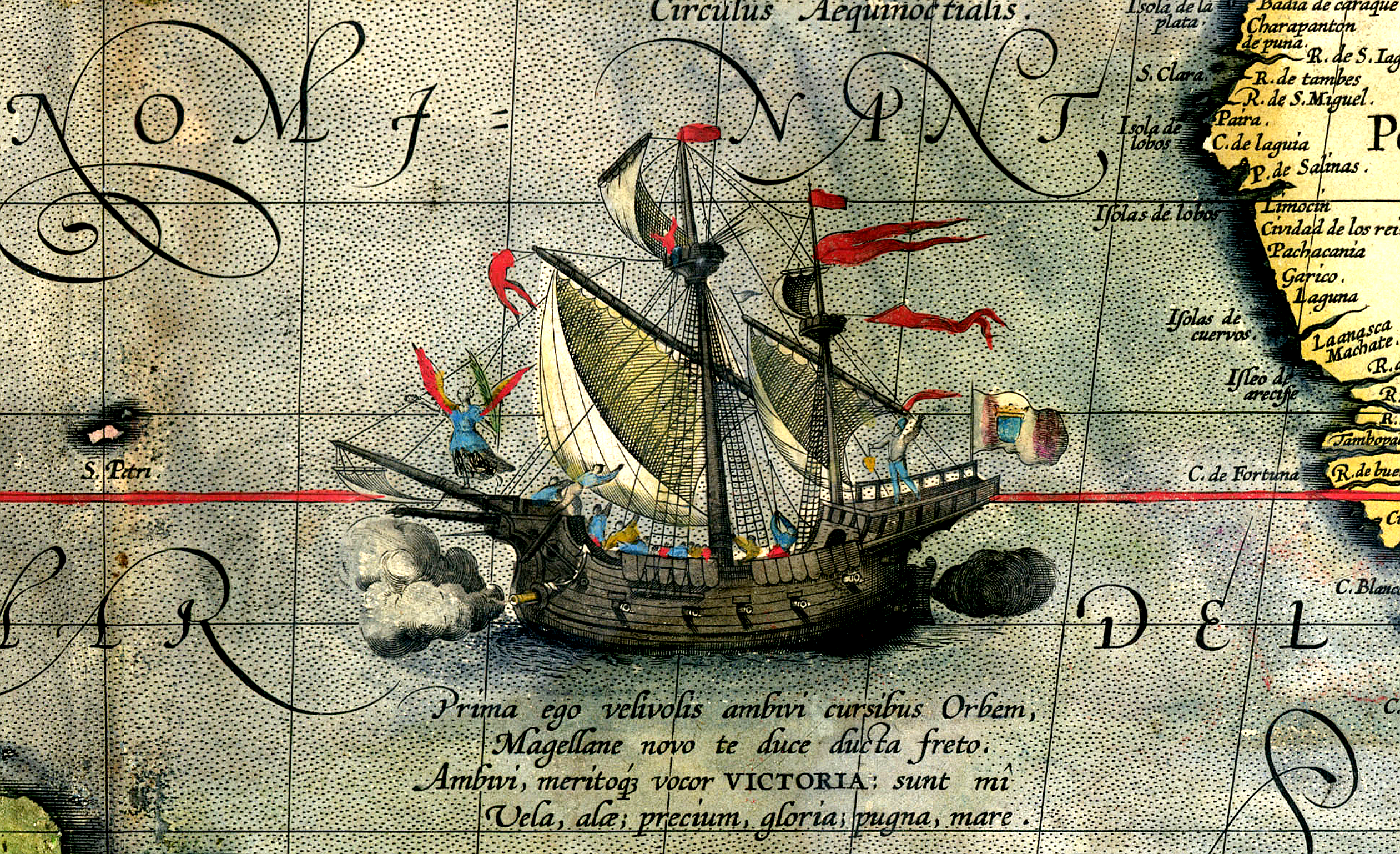
The carrack and the first circumnavigation of the earth: 1500 AD It was a carrack ship that completed the first full circumnavigation of the world. It took the Spanish expedition two captains and nearly four years to make the voyage. Portuguese captain Ferdinand Magellan, who initially led the expedition, set off from Spain in 1519 and died in the Philippines in 1521. Juan Sebastian Elcano brought the carrack ship Victoria – the only one of five ships that started the expedition to survive the trip – back to Spain in 1522. Carracks were three- to four-masted sailing ships developed by Genoan sailors in the 15th century for use in commerce. Their spacious cargo holds made them good for long-distance exploration and they were important in advancing European colonial expansion leading up to the Age of Discovery. Ocean-going ships that were large enough to be stable in heavy seas, carracks were square-rigged on the fore and main masts and lateen-rigged on the mizzenmast. “https://www.ybw.com/features/10-top-innovations-in-the-history-of-sailing-17358
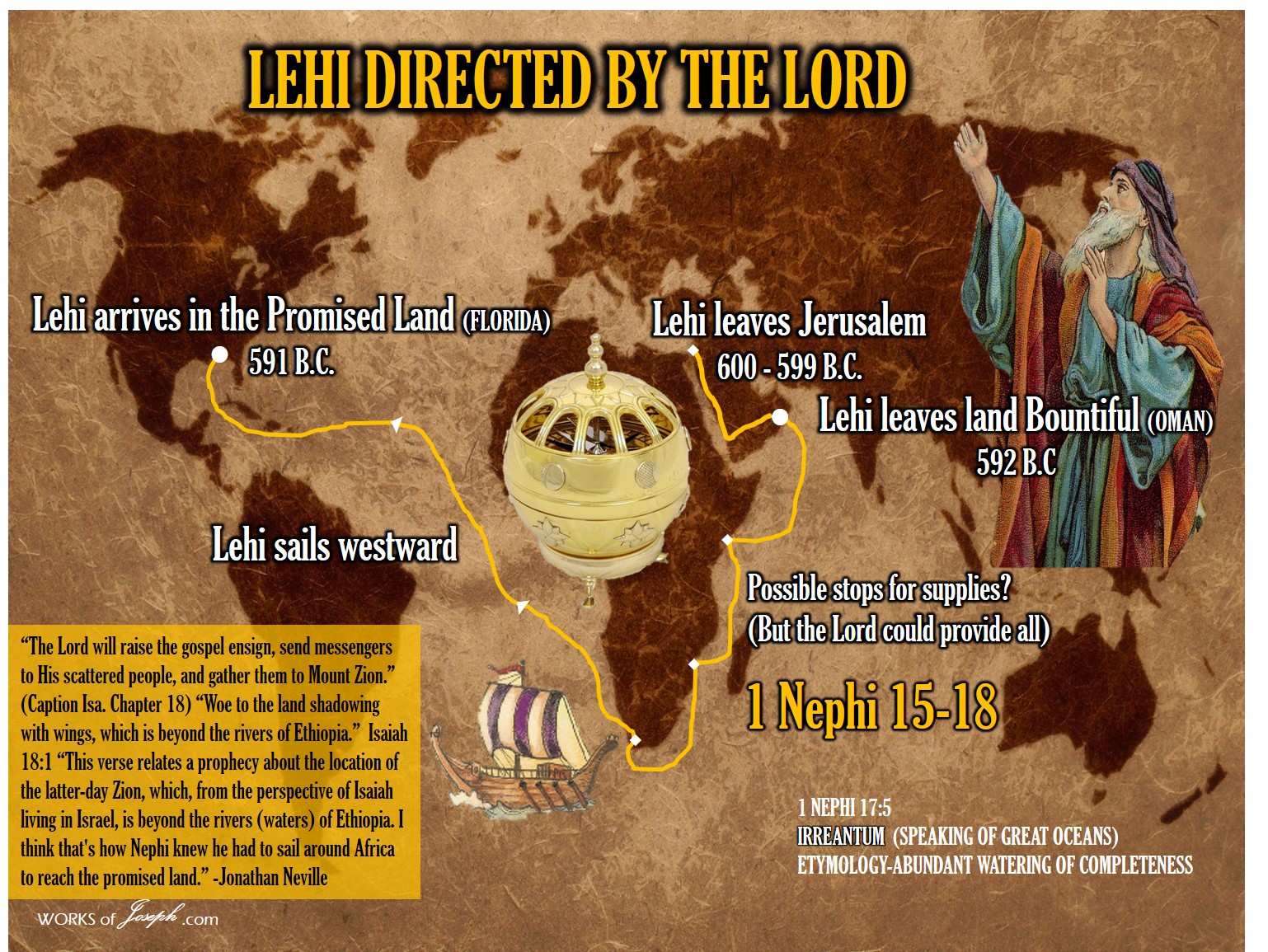
Conclusion: After All We Can Do!
It is my opinion that the Lord may have given Nephi instructions to build his ship by utilizing some of the inventions I mention or with Nephi using some of his own reflections and ideas that he had prayed about. I don’t believe the Lord would just make Nephi’s trip easy by simply allowing the Lords miracles to happen. The Lord has told us time and time again that he will step in after all we can do. Just like Joseph Smith and the translation of the Gold Plates. Joseph did not simply read words off of a rock in a hat, but by the gift and Power of God, which allowed Joseph to use his own mind, his ability to learn translation and utilize the two stones attached to a breastplate. JSH 1:35. Like with the Brother of Jared, God did not just make the stones shine, but it was the Brother of Jared who asked the Lord to touch the stones, as he had done all he could do, by molting the stones and then the Lord made them shine.
Nephi built a ship not after the manner of men, but after the manner the Lord instructed him. When we exercise faith, we don’t usually know what will happen next, but it just happens as the Lord directs.





